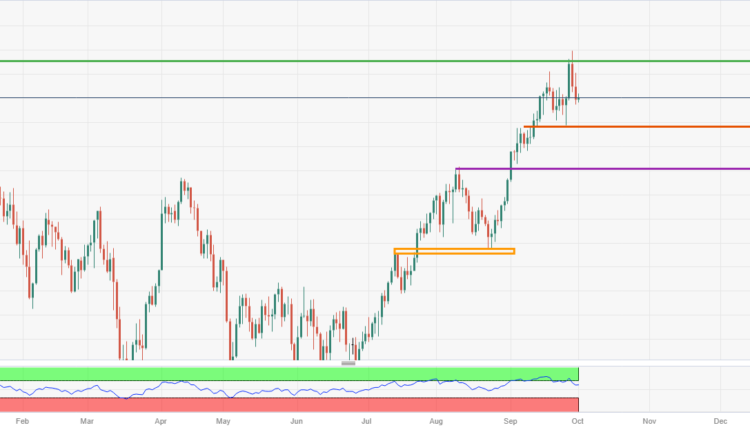Oil claws back above $90 as UAE energy minister backs OPEC+ cuts ahead of COP 28
- Oil (WTI) heads higher on Monday, halting the sell-off at the end of last week.
- The US Dollar is flat and under a bit of pressure from a risk-on market mood.
- The door is open towards $94 with more headlines underway in the wake of the Adipec meeting.
Oil prices are recovering from the firm decline registered on Thursday and Friday. Crude briefly touched $94 before selling off nearly 4.5%. Energy ministers and the Oil industry are gathering for the biggest energy conference in the Middle East, which could become a key catalyst for Oil prices throughout the week.
The US Dollar (USD) did not get much time to enjoy the party over its eleventh straight week of gains. It was a close call last week, with the US Dollar Index (DXY) locking in gains in the last few trading hours. The US government shutdown might be solved for now, but the US Congress pushed the budget showdown to November, kicking the can down the road for roughly six weeks as in mid-November the US Treasury will once again run out of funds.
Crude Oil (WTI) trades at $90.26 per barrel, and Brent Oil trades at $92.17 per barrel at the time of writing.
Oil news and market movers
- The annual Adipec summit is to take place in Abu Dhabi this week, with all important ministers and Oil producers in the Middle-East joining.
- In the wake of the start of the Adipec Summit, the United Arab Emirates (UAE) energy minister Suhail al Mazrouei said that OPEC+ has the right policy in place to deal with current market conditions.
- The crude Oil pipeline running from the Kurdistan region in Iraq to the Mediterranean coast of Turkey will resume operations this week, Turkish Energy Minister Alparslan Bayraktar said.
- Eni, the Italian energy company, and its CEO Claudio Descalzi said in a Bloomberg interview that more OPEC+ production cuts are highly unlikely and that the worst is over.
Oil Technical Analysis: $94 emerges as nearby target
Oil prices are recovering after the firm price decline recorded on Thursday and Friday. The fact that the sell-off gets halted that quickly means that traders and market participants are still buying the dip. This should see Crude pushing back up to $94 soon.
On the upside, the double top from October and November of last year at $93.12 remains the level to beat. Although it got breached on Thursday, the level never got a daily close above it. Should $93.12 be taken out, look for $97.11, the high of August 2022.
On the downside, a new floor is formed near $88 with the high of September 5 and 11 underpinning the current price action. Proof of this already exists with the dip of September 13 and September 21, which reversed ahead of $88. Should $88 break , the peak of August 10 needs to be enough to catch the dip near $84.20.
-638318418156608178.png)
US WTI Crude (Daily Chart)
WTI Oil FAQs
WTI Oil is a type of Crude Oil sold on international markets. The WTI stands for West Texas Intermediate, one of three major types including Brent and Dubai Crude. WTI is also referred to as “light” and “sweet” because of its relatively low gravity and sulfur content respectively. It is considered a high quality Oil that is easily refined. It is sourced in the United States and distributed via the Cushing hub, which is considered “The Pipeline Crossroads of the World”. It is a benchmark for the Oil market and WTI price is frequently quoted in the media.
Like all assets, supply and demand are the key drivers of WTI Oil price. As such, global growth can be a driver of increased demand and vice versa for weak global growth. Political instability, wars, and sanctions can disrupt supply and impact prices. The decisions of OPEC, a group of major Oil-producing countries, is another key driver of price. The value of the US Dollar influences the price of WTI Crude Oil, since Oil is predominantly traded in US Dollars, thus a weaker US Dollar can make Oil more affordable and vice versa.
The weekly Oil inventory reports published by the American Petroleum Institute (API) and the Energy Information Agency (EIA) impact the price of WTI Oil. Changes in inventories reflect fluctuating supply and demand. If the data shows a drop in inventories it can indicate increased demand, pushing up Oil price. Higher inventories can reflect increased supply, pushing down prices. API’s report is published every Tuesday and EIA’s the day after. Their results are usually similar, falling within 1% of each other 75% of the time. The EIA data is considered more reliable, since it is a government agency.
OPEC (Organization of the Petroleum Exporting Countries) is a group of 13 Oil-producing nations who collectively decide production quotas for member countries at twice-yearly meetings. Their decisions often impact WTI Oil prices. When OPEC decides to lower quotas, it can tighten supply, pushing up Oil prices. When OPEC increases production, it has the opposite effect. OPEC+ refers to an expanded group that includes ten extra non-OPEC members, the most notable of which is Russia.


Comments are closed.